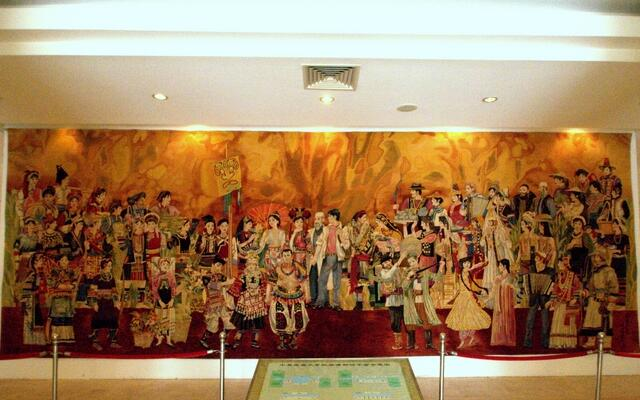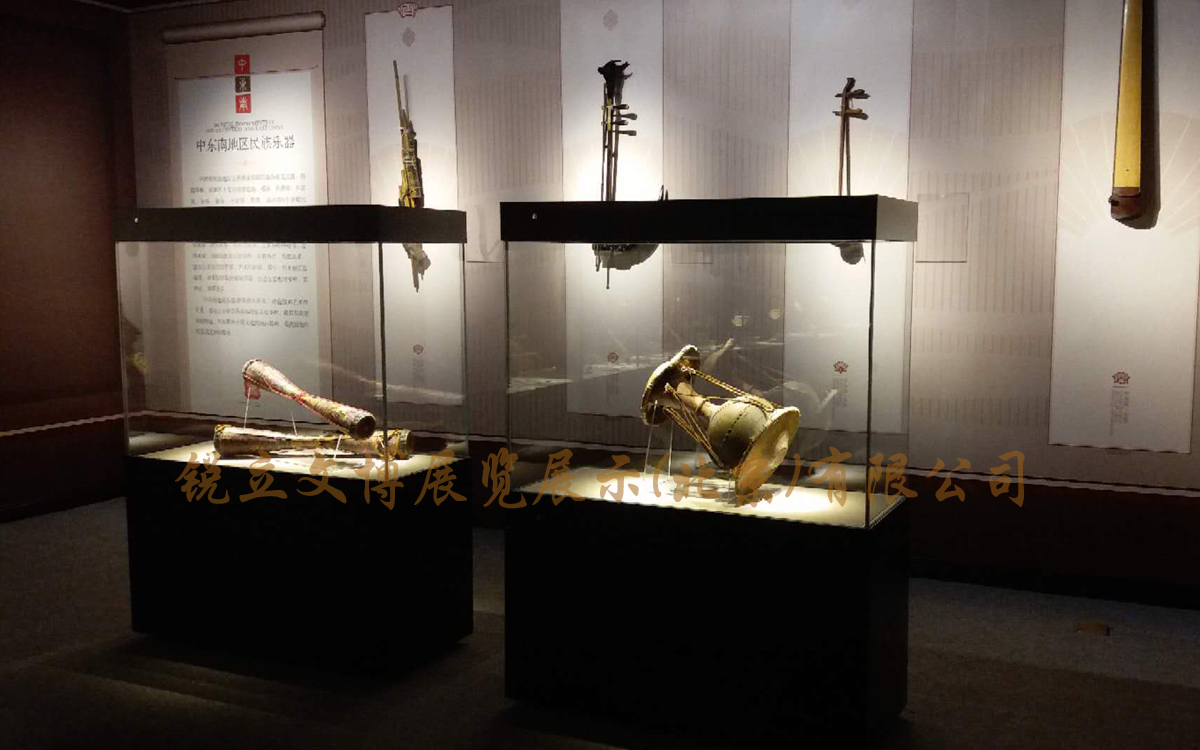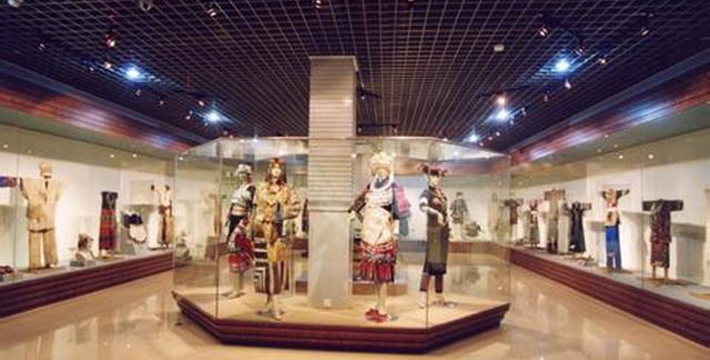MUC & Affiliated Units
Location
There is a quaint building in the southwest corner of the campus of Minzu University of China. The five shining characters of "The Museum of Ethnic Cultures" are hung above the main entrance implying the rich history of Chinese minority culture, welcoming visitors from all directions.

Overview & Development History
The MUC Ethnic Culture Museum was built in 1951, with a construction area of 4,800 square meters and an exhibition area of 1,800 square meters. It is a professional museum of ethnology displaying research objects encompassing cultural relics stemming from 56 ethnic groups making up for its main collection. The collection contains nearly 20,000 pieces (sets) of cultural relics in 14 categories, including production tools, daily necessities, religious artifacts, clothing, ancient artifacts, documents, and musical instruments of various ethnic groups. The majority are traditional folk costumes and decorations of various ethnic groups, which fully reflect the outstanding talents and exquisite skills of the people of all ethnic groups in China in the aspects of textiles, printing and dyeing, embroidery, leather tanning, and more. The collection includes prehistoric painted pottery jars, bronze drums from the Eastern Han Dynasty, Buddhist statues from the Ming and Qing dynasties, Tibetan thangkas, ancestral drawings, sky roads maps, bay leaf scriptures, and East Eight Classics. All of these have high historical and artistic value. Many were gifts given by the peoples of many ethnic groups in the early days of founding the People's Republic of China. The museum's display contents also have extremely high political significance and historical value. In particular, it is worth mentioning that the collection of Taiwanese minority cultural relics, both in terms of quantity and quality, is in a leading position compared to other similar domestic museums.

Permanent exhibition content of the MUC Ethnic Culture Museum includes the "Chinese Traditional Culture Exhibition," the "Northern Ethnic Costume Culture Exhibition," the "Southern Ethnic Costume Culture Exhibition," and the "Religious Culture Exhibition." Thematic exhibitions include the "Taiwan Minority Cultural Relics Exhibition," the "MUC History Exhibition," the "Chinese Minority Headwear Culture Exhibition," the "Minority Characters Calligraphy Exhibition," and the "Chinese Ethnic Ancient Characters and Ancient Books Exhibition Hall" and more.
Museum Focus, Beliefs & Development Objectives
The MUC Ethnic Culture museum has long adhered to serving teaching and scientific research and serving society, and actively using its cultural relics collection. Dozens of exhibitions have brought about good social benefits. Party and state leaders Zhou Enlai, Chen Yi, Ulanhu, Yang Jingren, Zhu Rongji, Wang Zhongyu, Xi Jinping, Liu Yandong, Yu Zhengsheng, Prince Sihanouk, Prime Minister Bhutto, and other foreign heads of state have visited and inspected the museum and fully affirmed the work of the museum. For example, President Xi Jinping said emotionally, "how enlightening" after listening to the costume hall's explanation. The various exhibitions held in the museum have become important classrooms for the university and middle and elementary school students and the general public to gain further knowledge of national traditions and strengthen their sense of patriotism. In 2006, the museum was designated by the State Ethnic Affairs Commission as a "National Unity and Progressive Education Base." Other than this, the Beijing Municipal Education Commission designated it as the "Beijing Haidian District Patriotic Education Base" and the "Beijing Haidian District Youth Off-campus Education Base." Moreover, the museum was awarded the title of "Beijing Out-of-school Education Advanced Group (2010)", a title jointly awarded by Beijing Municipal Education Commission and Beijing Municipal Human Resources and Social Security Bureau.

The museum's digital exhibition construction is taking a leading edge when compared with other museums in its category around the country. Digitization of ethnic museums involves using modern information technology to digitize collections and conduct relevant management and service of ethnic museum collections. In 2006, MUC invested more than 200,000 yuan from the "211 Project" to carry out the first phase of the "MUC Digital Museum" project. The project content mainly includes constructing the website and the exhibits' multimedia production regarding "Taiwan Minorities." The second phase of the project encompasses the Ministry of Education with information on "China University Digital Museum Construction (Phase II)" and the "MUC Digital Museum" with total funding of 120,000 yuan. This phase of the project's main content is to digitalize exhibits covering the northern folk costumes and the southern folk costumes exhibition halls. Through multimedia methods such as three-dimensional interactive functionality and flat digitization, more than 200 exhibits can be viewed and browsed online. In 2008, the "Digital Ethnic Museum" project declared by the museum to the National Development and Reform Commission was approved. The project funding amounted to 4 million. This phase of the project will collect image data and database construction for more than 20,000 cultural relics in 14 categories and carry out 500 aspects of detailed work. It will include three-dimensional image processing as well as digital plane processing of 3000 cultural relics. After completing the above three phases of digital ethnic museum construction projects, the cultural relics management system will be transformed from the original manual and paper media management methods into a modern digital management system. The management level of cultural relics will not only leap to a new level (an advanced domestic level), scientific protection and effective use of cultural relics will also be realized. A solid foundation will be established to expand different channels and methods for teaching and scientific research and public service.
Academic Exchanges and Cooperation at Home and Abroad
The MUC Ethnic Culture Museum also hosts major national commemorative activities. For example, between September 26-30, 2004, it specifically hosted the "Chinese National Costume and Apparel Exhibition," one of the series of activities of the CPPCC "Celebrating the 55th Anniversary of the Founding of the People's Republic of China and the 55th Anniversary of the Founding of the Chinese People's Political Consultative Conference". Fu Tieshan (Vice Chairman of the Standing Committee of the National People's Congress), Wang Zhongyu (Vice Chairman of the CPPCC National Committee) as well as Ding Guangxun, Bai Lichen, Abulait Abdurexit, and other responsible comrades of relevant ministries and commissions of the National People's Congress such as Li Zhaozhuo and others all attended the opening ceremony of this event. During the period, 12 national costume exhibitions were held, with more than 6,000 visitors attending. The national costume exhibition alone received thousands of visitors. The exhibition displayed and promoted the breadth and depth of Chinese national costume culture dynamically.

On the occasion of "5.18 International Museum Day" in 2015, the museum took the lead in landing at the "Google Cultural Institute" at the Shanghai World Financial Center, taking the lead in integrating and promoting Chinese national culture to the world. This step marks the opening of the era of global cross-temporal virtual exhibitions for the MUC Ethnic Culture Museum. The first batch of 13 online exhibitions includes the "Northern Ethnic Costumes Exhibition," the "Southern Ethnic Costumes Exhibition," the "Minority Headwear Exhibition," and "the Taiwan Minority Artifacts Exhibition." They have been launched in both Chinese and English. At the same time, they also provide 360-degree online exhibitions in the high-definition real-life display, allowing the audience to conduct virtual tours of the entire museum. There are also Gigapixel ultra-high-definition hall silk carpet pictures on display for appreciation. Moreover, all the high-definition pictures of exhibits can be enlarged at will.
Museum Slogan
In the future, the MUC Ethnic Culture Museum will focus on constructing physical and virtual museums, constantly presenting the Chinese nation's beauty to the audience, and making greater contributions to enhancing mutual understanding among different people of different nations.

Official MUC Ethnic Culture Museum Website (In Mandarin): https://bwg.muc.edu.cn/

